One of the sad by-products of the last couple years is the unfortunate loss of some of our favorite retail locations and restaurants in our urban centres. Having an office located in downtown Toronto, it has been disheartening to watch as one after another of the windows of long-time establishments have been boarded up and as small business owners have had to make tough decisions to close their doors for good.
As a fellow business owner, my heart goes out to anyone who has had to go through this, and I have asked myself – will they be able to make a comeback? As someone in the Fire and Life Safety industry, I have also asked myself when a building is abandoned, what happens to its level of safety?
You can go back and take a read of Kyle Chamberlain’s post (Vacant Buildings and Fire Safety: Negotiating a Balance) which talks about vacant buildings and how it is not addressed in the National Fire Code and some great advice on dealing with AHJs and the potential of Building owner Absenteeism.
When I looked a little closer at this issue however I learned that our team here have helped clients with this exact issue as it related to proactively decommissioning Life Safety systems and vacating the building properly under guidance of codes and by-laws. The reason this is the case here is due to the fact that the Ontario Fire Code has a section dedicated to the decommissioning of such systems and the City of Toronto has sections in its Municipal Codes for vacant buildings. Perhaps there are other parts of the country where this is also addressed in more detail – so please feel free to comment below.
“OFC Article 6.9.1.1. prohibits any fire protection equipment or life safety systems from being decommissioned or taken out of service without the prior authorization and approval of the Chief Fire Official”
Here in Toronto, the first place to look for these requirements is the Ontario Fire Code. OFC Section 6.9, “Decommissioning”, outlines the requirements applicable to the decommissioning of fire protection equipment and life safety systems in occupied buildings. Effectively, OFC Article 6.9.1.1. prohibits any fire protection equipment or life safety systems from being decommissioned or taken out of service without the prior authorization and approval of the Chief Fire Official. In the context of the OFC, fire protection equipment and life safety systems include: fire extinguishers, fire alarm systems (alarm and voice communication systems), standpipe and hose systems, sprinkler systems, emergency power systems, and special fire suppression systems. It will be the building owner’s responsibility to get this approval if they plan to decommission and no longer keep up with the inspection, testing and maintenance requirements on these systems while the space is abandoned (see my past posts on ITM Here and Here). If this process is not undertaken then the building owner will still be required to meet all applicable maintenance requirements under the Fire Code in relation to the Life Safety systems, regardless of whether the premises are occupied. Translation: when I am walking by those abandoned buildings, if the owner is meeting their obligations, then they are either safe from a life safety perspective for occupancy or the Chief Fire Official is aware that these systems have been properly taken off-line for while it is unoccupied.
We can go a step further and take a look at what guidance there is from our municipal by-laws with respect to abandoned buildings. Here in Toronto, the Toronto Municipal Code, Chapter 629, “Property Standards”, includes regulations for vacant buildings and property under § 629-24, “Vacant buildings and property”. § 629-24.A specifically states that: “The owner of any unoccupied building or other vacant property shall protect the building or property against the risk of fire, accident or other danger, by effectively preventing the entrance to it of all unauthorized persons”. It also gives specifics on materials and methods for covering windows and doors, to ensure this is undertaken properly. Another section of interest is § 629-24.D, which states that where a building remains vacant for a period of 90 days or more, the owner is required to ensure that all utilities serving the building are properly disconnected or otherwise secured to prevent accidental or malicious damage to the property or adjoining premises. You can see where being required to turn off services such as electricity and water could directly affect the operability of life safety systems such as fire alarm panels and sprinkler systems that rely on these services. This is another reason that an abandoned building may require decommissioning of life safety systems. Similar to the requirements of the Fire Code, all of these responsibilities fall to the owner of the property.
So, the next time you walk by a boarded up building (at least here in Toronto), you can set your mind at ease in one sense – there are codes and regulations in place requiring that the proper attention is taken for life safety and you can focus your concern on doing what we can to get our local establishments back on their feet again.


One Response
Great note Gerry, it’s pretty well known that people are responsible for many fires through inappropriate actions or negligence. We must also remember that those same people also help to keep a building safe. An unoccupied building is more vulnerable for lack of those maintaining normal activities and travelling throughout the building day to day.